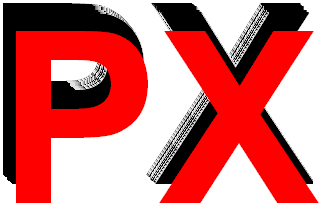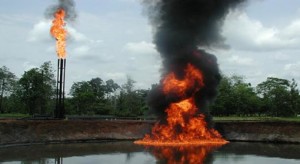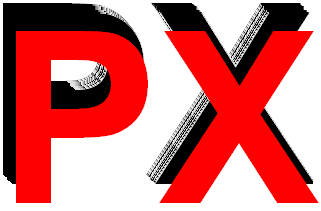Chevron: The Killer Hand of Greed
- By Poetry X
- 1 June, 2014
- No Comments
The invisible hand of Adam Smith in the Ecuadorian Amazon is the killer hand of Chevron. The case of Chevron is a case on point of crime, corruption, violation of sovereignty, extreme racism and even worse, a case of human rights violations. Furthermore, this has become a global struggle against the abuses of the multinationals against the environment and the rights of Indigenous people around the world. Chevron’s greed has left behind a trail of destruction and death in many other countries like Indonesia, Brazil, Rumania, Canada, Nigeria and even in the US. In the Ecuadorian Amazon, a beautiful green rainforest sparkling in live with pristine waters and colorful biodiversity was reduced to a toxic wasteland of dirty crude oil [Amnesty International].
First, we must remember Texaco merged with Chevron in 2002 to form the Chevron corporation. From 1964 until 1990 Texaco was the only corporation operating in the affected areas of Ecuador. In a blatant exhibition of extreme greed and racism, Texaco incurred in unethical, hazardous and even illegal practices just to maximize profit at the expense of the environment and the health of the Indigenous people living in the area.
Remember in 1989 the Exxon Valdez tanker disaster off the coast of Alaska spilled 10.8M gallons of oil into the sea. On the other hand, Chevron is responsible for 16.8M gallons of crude oil spilled into the forest. And even worse, from 1972 until 1992, Texaco intentionally dumped more than 19B gallons of toxic waste waters into Amazon.
Chevron refuses to clean up the disaster, alleging Texaco did clean up the oil waste but the evidence shows differently. There are stinking unlined pits of old oil residue leaking into drinking water and into the soil. Back in 1995 Chevron got a deal with a corrupt Ecuadorian government. The Ecuadorian State would release the oil company from any liability in exchange for Chevron cleaning up all the sites. Ecuador dropped all legal proceedings but Chevron just thew dirt to somehow cover the leaking pits of oil [Chevron Toxico].
Under that “clean up agreement” the Ecuadorian State cannot sue Chevron for any of the operations before 1992, but that agreement does not involve private citizens. Therefore the Indigenous people have no restriction to sue this corporation. However, Chevron, besides refusing to clean up the pollution left behind, also denies to pay any compensation to the affected communities. Keep in mind Chevron revenues exceed the entire Ecuador’s GDP. Chevron removed all its assets from Ecuador to avoid any risk of asset confiscation for any reparation payment.
CONSEQUENCES
First, the biggest crime of Texaco, now Chevron, is the human tragedy caused by its extreme greed and a mortal racism on the eyes of many. While Chevron, was extracting oil in the US, they used the best technology not to harm the environment. However, in Ecuador, Chevron didn’t care at all and did whatever possible not to spend any additional money, affecting an area of roughly the same size as Massachusetts or Wales with a population of 44’000 inhabitants. The contamination left by Chevron threatens the survival of Indigenous populations as well as those who seek to protect their communities and their environment. [Amazon Crude” by Judith Kimerling] The irresponsible oil extraction practices left dead rivers, unusable roads across the forests and polluted air [The Guardian Mar 18-2014].
In some streams, the levels of chemical contamination is as high as 280 times the permitted levels in the European Union. As a result of the massive chemical contamination, cancer, abortion, birth defects, infant mortality and many other chronic ailments are in record high numbers. As a result some Indigenous groups could go extinct.
It is not strange to find cases of children going to hospitals for vomiting blood related to drink contaminated water [Gregpalast]. Farmers have their skin covered in pustules on the affected areas of the Amazon but Chevron lawyers say there is no evidence to link Chevron’s activity with these health conditions [1999 Yana Curi Report / International Journal of Occupational and Environmental Health].
CORRUPTION AND EXTORTION
The second aspect of the Chevron case is the corruption and extortion practices of this corporation. Chevron, like other multinationals, has entire armies of lawyers, public relations specialist, Strategists, planers, and not less importing, lobbyists that buy US politicians to protect their interests. Just for this case Chevron has hired about 2’000 lawyers from 60 firms [Huffington Post Aug 17-2013].
One of the main characteristics of this hubristic entities like Chevron is they feel entitled to be above the law. Right after the lawsuit was filed, Chevron stated they will fight until hell freezes over and then fight it out on the ice. In fact, They have blackmailed politicians, lawyers and even pinhead judges stating that allowing the Ecuadorians to get any reparation would destroy the entire “global business” [Greg Palast]. Since the beginning Chevron tried to prevent victims of having any legal counsel.
In 1993, the Indigenous people of the affected areas filed a law sue against Texaco for damages to the Amazon in the courts of New York. In 2003, Chevron gets to take the case from the courts of New York to an Ecuadorian Court. In 2011, the court declared Chevron guilty for contamination, and imposed $9.5B in compensation with an official apology in the coming two weeks. Chevron refused to apologize so the sentence was augmented to $19B, but Chevron refused to recognize the validity of the sentence. In 2013, The Ecuadorian Court put the compensation back on $9.5B and ratified Chevron is responsible for damages in the affected areas.
A major judicial backlash against the indigenous and their lawyers Boggs occurred in 2014. In a New York court, judge Lewis Kaplan determined the sentence in Ecuador is invalid under the RICO act (Rackeer Influenced and Corrupt Organizations) exonerating Chevron from any responsibility accusing the claimants of incurring into bribery and corruption [Dayly Koz Mar 10-14]. Notice that Judge Alberto Guerra, its star witness, and he has admitted that Chevron paid him $48,000 for physical evidence of bribery as well as travel expenses for him and his son’s families to flee Ecuador. In top that Chevron would cover attorneys fees and committed to pay him $12,000 per month for living expenses in the US for two years. We must know the RICO Act is normally reserved for prosecuting members of the mafia. Chevron sued the victims and their US attorney, Patton Boggs, based on Kaplan’s sentence and won the lawsuit. Boggs withdrew from the case after Chevron threatened legal action over the firm’s role in the case. Boggs also agreed to pay Chevron $15M [Business Week Apr 17-2014].
A devastating possibility was open for Chevron which could economically break the Ecuadorian state. In 2006, Chevron filed and arbitrage procedure against the Ecuadorian Government before the ICJ (International Court of Justice) alleging violations of the United States-Ecuador Bilateral Investment Treaty, a criminal treaty that was singed in 1993 by a corrupt President, and put in effect in 1997. Note that Chevron left Ecuador in 1992 which disqualifies Chevron from any protection under this treaty [Cuenca High Life].
POLITICAL PLOT
Chevron’s interests in Ecuador go beyond just a judicial trouble. Since the very beginning, this corporation has been implicated in the political ups and down of the South American nation. Nowadays Ecuador is leaded by a extremely popular elected President, Rafael Correa, a very achieved academic economist and it seems Chevron will not miss the opportunity to destabilize this left leaning government.
During the 1970’s, during the time of the military dictatorship, Ecuador finally finished paying its debt to England, a debt that had incurred for its independence in the 1830’s. Very quickly, the dictatorship bestowed very generous concessions to the oils companies including Texaco.
The first elected president after the dictatorship was Jaime Roldos – in 1979. This president won the elections unexpectedly and started a nationalist agenda claiming the resources for the people. In 1981 Roldos refused to accept the conditions demanded by these oil companies operating in Ecuador, Texaco and Shell [Telegrafo May 24-2013]. Soon after, Roldos announced the nationalization of oil and stated to promote democratic alliances with the region, a move that was seen a threat to the US [Daily Censored]. Weeks after that, Roldos died in a very suspicious airplane crash. A very incomplete investigation determined the airplane crash was an accident [Survincity Mar 2011].
Not surprisingly for many, right after Roldos’s death, Texaco started very good relations with the high authorities of Ecuador once again. We must note other similar events with oil companies involved like Shell in Nigeria responsible for the death of Saro Wiwa, the BP for overthrowing elected president Mosadeq from Iran [New York Times Apr 16-2000 / CIA Apr 14-2007], toppling down president Yanukovych in Ukraine to put Vice President Biden’s son, Hunter Biden, in the board of Ukraine’s largest private gas firm [Washington Post May 14-2014], the overthrow of president of Honduras Manuel Zelaya on 2009 right after singing an oil contract with Petro Caribe, instead of renewing with Exxon and Chevron [Washington Post Jan 14-2007], and the coup against Fernando Lugo in Paraguay in 2012 to make the way in for Dahava Oil [Oil VoiceAug 7-2012].
In August 2010, a journalist named Mary Cuddehe wrote about the efforts by Kroll company, a private investigations firm, to recruit her as a “corporate spy” for Chevron. According to Cuddehe, Kroll offered her $20,000 to pose as a journalist while conducting interviews to undermine a study of the health effects of the oil spill. At this point it is just a given that US and Colombia spied and spy many functionaries of the government, including the president. Any time experts were scheduled to measure the impact of the contamination, some how Chevron managed to get that information in advance [Spooky Business].
In 2008, Sam Singer, a US crisis management guru, sent a memo to Chevron spokesperson Ken Robertson advising him who to assemble a major propaganda attack agains the Ecuadorian Government. Chevron would lead a media campaign to portray Ecuador’s court system as corrupt and to mount “counter attacks” on the plaintiffs and their legal team. Chevron has subpoenaed more than 100 email accounts, including those of environmental activists and journalists.
To make matters worst, it was revealed Chevron had contracts with an Ecuador Military security firm, SEPRIV. The case is very controversial since also Colombian people who belonged to the DAS (Colombian Administrative Security Department)are involved and even the IV Division of the Amazon Ecuadorian Army. All of these events clearly reveal a massive hidden intervention against the Ecuadorian government with Chevron being one of the prominent players.
TAKE ACTION
In conclusion, the ruthless quest to maximize profits by this criminal corporation, Chevron, has left many innocent people dead or in danger of dying, and also has put a sovereign and democratically elected government in danger of bankruptcy. If Chevron wins the case in the ICJ, it will break the Ecuadorian economy for many years to come. Just click on the picture on the head of this article and once in that page just fill your information on the key “APOYAR.” You can see the “APOYAR” blue button on the upper right of the site. Also sign the Daily Cos petition.
Blessings and let’s stop Chevron.


 Copyright © 2025
Copyright © 2025
Leave a Reply